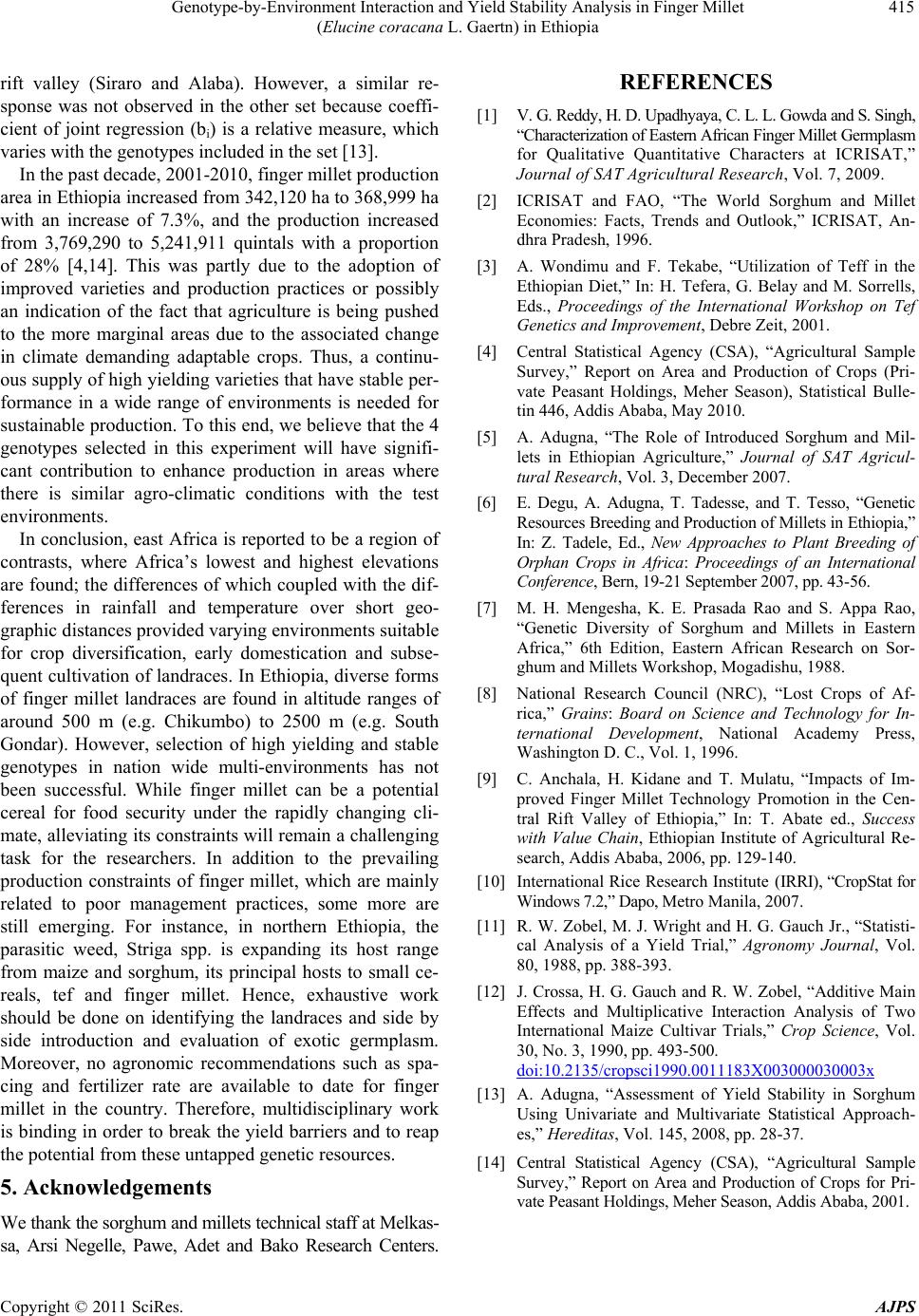
Genotype-by-Environment Interaction and Yield Stability Analysis in Finger Millet 415
(Elucine coracana L. Gaertn) in Ethiopia
rift valley (Siraro and Alaba). However, a similar re-
sponse was not observed in the other set because coeffi-
cient of joint regression (bi) is a relative measure, which
varies with the genotypes included in the set [13].
In the past decade, 2001-2010, finger millet production
area in Ethiopia increased from 342,120 ha to 368,9 99 ha
with an increase of 7.3%, and the production increased
from 3,769,290 to 5,241,911 quintals with a proportion
of 28% [4,14]. This was partly due to the adoption of
improved varieties and production practices or possibly
an indication of the fact that agriculture is being pushed
to the more marginal areas due to the associated change
in climate demanding adaptable crops. Thus, a continu-
ous supply of high yielding varieties that have stable per-
formance in a wide range of environments is needed for
sustainable production. To this end, we believe that the 4
genotypes selected in this experiment will have signifi-
cant contribution to enhance production in areas where
there is similar agro-climatic conditions with the test
environments.
In conclusion, east Africa is reported to be a region of
contrasts, where Africa’s lowest and highest elevations
are found; the differences of which coupled with the dif-
ferences in rainfall and temperature over short geo-
graphic distances provided varying environments suitable
for crop diversification, early domestication and subse-
quent cultivation of landraces. In Ethiopia, diverse forms
of finger millet landraces are found in altitude ranges of
around 500 m (e.g. Chikumbo) to 2500 m (e.g. South
Gondar). However, selection of high yielding and stable
genotypes in nation wide multi-environments has not
been successful. While finger millet can be a potential
cereal for food security under the rapidly changing cli-
mate, alleviating its constraints will remain a challenging
task for the researchers. In addition to the prevailing
production constraints of finger millet, which are mainly
related to poor management practices, some more are
still emerging. For instance, in northern Ethiopia, the
parasitic weed, Striga spp. is expanding its host range
from maize and sorghum, its principal hosts to small ce-
reals, tef and finger millet. Hence, exhaustive work
should be done on identifying the landraces and side by
side introduction and evaluation of exotic germplasm.
Moreover, no agronomic recommendations such as spa-
cing and fertilizer rate are available to date for finger
millet in the country. Therefore, multidisciplinary work
is binding in order to break the yield barriers and to reap
the potential from these untapp ed genetic resources.
5. Acknowledgements
We thank the sorghum and millets technical staff at Melkas-
sa, Arsi Negelle, Pawe, Adet and Bako Research Centers.
REFERENCES
[1] V. G. Reddy, H. D. Upadhyaya, C. L. L. Gowda and S. Singh,
“Characterization of Eastern African Finger Millet Germplasm
for Qualitative Quantitative Characters at ICRISAT,”
Journal of SAT Agricultural Research, Vol. 7, 2009.
[2] ICRISAT and FAO, “The World Sorghum and Millet
Economies: Facts, Trends and Outlook,” ICRISAT, An-
dhra Pradesh, 1996.
[3] A. Wondimu and F. Tekabe, “Utilization of Teff in the
Ethiopian Diet,” In: H. Tefera, G. Belay and M. Sorrells,
Eds., Proceedings of the International Workshop on Tef
Genetics and Improvement, Debre Zeit, 2001.
[4] Central Statistical Agency (CSA), “Agricultural Sample
Survey,” Report on Area and Production of Crops (Pri-
vate Peasant Holdings, Meher Season), Statistical Bulle-
tin 446, Addis Ababa, May 2010.
[5] A. Adugna, “The Role of Introduced Sorghum and Mil-
lets in Ethiopian Agriculture,” Journal of SAT Agricul-
tural Research, Vol. 3, December 2007.
[6] E. Degu, A. Adugna, T. Tadesse, and T. Tesso, “Genetic
Resources Breeding and Production of Millets in Ethiopia,”
In: Z. Tadele, Ed., New Approaches to Plant Breeding of
Orphan Crops in Africa: Proceedings of an International
Conference, Bern, 19-21 September 2007, pp. 43-56.
[7] M. H. Mengesha, K. E. Prasada Rao and S. Appa Rao,
“Genetic Diversity of Sorghum and Millets in Eastern
Africa,” 6th Edition, Eastern African Research on Sor-
ghum and Millets Workshop, Mogadishu, 1988.
[8] National Research Council (NRC), “Lost Crops of Af-
rica,” Grains: Board on Science and Technology for In-
ternational Development, National Academy Press,
Washington D. C., Vol. 1, 1996.
[9] C. Anchala, H. Kidane and T. Mulatu, “Impacts of Im-
proved Finger Millet Technology Promotion in the Cen-
tral Rift Valley of Ethiopia,” In: T. Abate ed., Success
with Value Chain, Ethiopian Institute of Agricultural Re-
search, Addis Ababa, 2006, pp. 129-140.
[10] International Rice Research Institute (IRRI), “CropStat for
Windows 7.2,” Dapo, Metro Manila, 2007.
[11] R. W. Zobel, M. J. Wright and H. G. Gauch Jr., “Statisti-
cal Analysis of a Yield Trial,” Agronomy Journal, Vol.
80, 1988, pp. 388-393.
[12] J. Crossa, H. G. Gauch and R. W. Zobel, “Additive Main
Effects and Multiplicative Interaction Analysis of Two
International Maize Cultivar Trials,” Crop Science, Vol.
30, No. 3, 1990, pp. 493-500.
doi:10.2135/cropsci1990.0011183X003000030003x
[13] A. Adugna, “Assessment of Yield Stability in Sorghum
Using Univariate and Multivariate Statistical Approach-
es,” Hereditas, Vol. 145, 2008, pp. 28-37.
[14] Central Statistical Agency (CSA), “Agricultural Sample
Survey,” Report on Area and Production of Crops for Pri-
vate Peasant Holdings, Meher Season, Addis Ababa, 2001.
Copyright © 2011 SciRes. AJPS